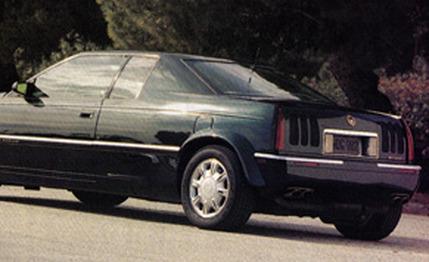 Specialty File
Specialty File
According to Warren Mosler, the bond trader and automotive dabbler extraordinaire, the TwinStar was born of a project originally intended to convert a Cadillac Eldorado into a mid-engined car.
But when it was done, says Mosler, the Eldo worked quite well as a twin-engined car, so that's the way he left it. That's his story, and he's sticking to it. And you can see the appeal of his reasoning: Two engines add up to 575 horsepower (in this case) and four-wheel drive.
Apart from the hassles involved in the fabrication of a rear-engine subframe and suspension pickup points, the job isn't that hard. Since each engine operates independently, there's no need to synchronize anything other than gear selection and throttle position. In fact, Mosler's car wears two distinctly different engines. The one up front is a 275-hp Northstar like that found in the base Eldo, and the one in back is the 300-hp unit that comes in an ETC. The rear engine has a higher redline and uses lower gear ratios, so the engines shift at different times as the car accelerates.
At first, this seems weird, but it feels normal after a while, particularly since it smoothes the usual interruption in thrust that occurs even in cars with automatic transmissions. With the TwinStar, while one engine shifts, the other continues to pull hard. The disparity in power fore and aft is faintly detectable and is sensed as a harder push from the rear, although it's possible that impression is the result of the louder rear-engine exhaust.
Actually, there is reason to suspect that the front engine had a few technical glitches. According to Mosler, the front engine resents being rammed into its rev limiter by the rear engine, something that happened during testing. The engine computer, he says, defaults to a weaker-running mode. Maybe that's true, but since we tested the car twice -- once before its engine electronics were checked out by Mosler's Johnny Omundsen and again after he'd plugged in new chips (the boxes they came in were in the car) -- we'd say the problems lie elsewhere.
After all, our first performance results were fractionally faster than a second batch. We've published those here, but the second tests added a 10th or so to some of the times. Either way, the TwinStar isn't slow, clawing its way to 60 mph in 5.0 seconds and on through the quarter in 13.4 seconds at 108 mph. That's a good bit quicker than our last Eldorado Touring Coupe's 6.8-second sprint to 60 mph and quarter-mile time of 15.2 seconds, but Mosler's guys claim repeatable 12.7-second quarters and 4.6-second blasts to 60 mph.
The downside of a twin-engined Eldo is a peculiar long-wheelbase look coupled with fairly porky mass -- 4780 pounds at the curb. Our overall gas-consumption rate worked out to a relatively gluttonous 10 mpg, too, but this pales into insignificance when you start the car in a gas-station forecourt. See, the normal ignition key starts the front engine, but you then have to thumb a little black switch on the center console to start the rear engine. That gets the attention of everyone within earshot, we can tell you.
The long-wheelbase look and vented trunklid also attract some attention. Some civilians asked if the engine was in the back, and when we answered affirmatively -- adding that there was an engine in front, too -- most people looked puzzled, wondering why. Only one guy, a Harley Fat Boy rider who hove alongside to ask questions, seemed to grasp the concept. "Two engines?" he asked. We nodded.
"Cool," he said with a huge grin, and blatted off.
For some people, two engines are obviously better than one. But by now you're probably asking yourself how that extra engine affects the car's handling. Not as much as we'd expected. On freeways, the long wheelbase and the hefty rear polar mass make themselves felt as a peculiar rear-end sway, but the car actually handles pretty well in the corners.
We enlisted the aid of a race-car driver at Willow Springs to help us time skidpad passes and then took him for a ride around the track as a reward. By the end of one lap he was grinning broadly. "This thing's amazingly well-balanced" was his observation. And so it is, once the rear end has rolled over and taken a set. It's good enough to pull 0.83 g.
Other than the loss of the trunk, now filled with Northstar hardware, the TwinStar isn't as impractical as you'd think. The rear seat is unaffected by the conversion, other than it now has the CD changer mounted on the rear window's parcel shelf, so it's still a usable space.
And the front seating arrangement is utterly stock, although there is an extra instrument panel mounted in front of the passenger. Watching the two tach needles swing on different schedules is a fascinating business, but having two identical-spec engines would probably avoid the need for this redundant gimmick.
According to Mosler, the conversion costs about $30,000, with you bringing your own Cadillac. The company can supply the extra engine, which is included in that cost.